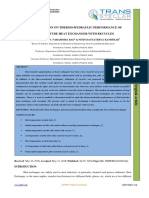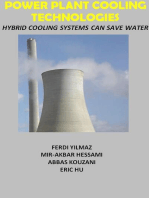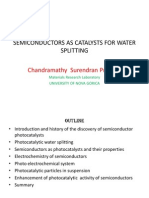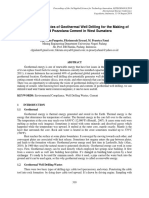Heat Exchanger Technology Review From PEI Magazine
Heat Exchanger Technology Review From PEI Magazine
Uploaded by
Stephen ChuaCopyright:
Available Formats
Heat Exchanger Technology Review From PEI Magazine
Heat Exchanger Technology Review From PEI Magazine
Uploaded by
Stephen ChuaOriginal Description:
Original Title
Copyright
Available Formats
Share this document
Did you find this document useful?
Is this content inappropriate?
Copyright:
Available Formats
Heat Exchanger Technology Review From PEI Magazine
Heat Exchanger Technology Review From PEI Magazine
Uploaded by
Stephen ChuaCopyright:
Available Formats
Stephen R.
Chua BSEE5A Topic: A Research on Electrical Control System Journals
Heat Exchanger Technology: Bundling for Performance by Jrg Stahlnut of Balcke-Drr in Oberhaussen, Germany
Article Overview: In today's competitive markets, electric utilities are constantly striving to maximize the efficiency and reliability of existing power plants. But although most might consider their equipment to be already optimized, there are still many parts of the world where power plants are operating with inefficient water-cooled turbine surface condensers.
System being investigated
The article by Jrg Stahlnut emphasizes the importance of condensers, and its performance as a significant factor in the overall operational efficiency of a power plant. Condensers, in the sense of electric generation system, is used as a way of controlling and transferring heat, where it will produce steam by boiling water; thence, the condensers are also known as heat exchangers.
Objectives
The objectives of the article are implied all throughout the article; the author wants to give details on the operations of the condensers; to hint the readers on the importance of efficient condensers; to analyze the tube bundle design; and to explain the importance and simulation analysis of new designs of the condensers. The author successfully attained the objectives. He started the article directly enumerating the qualities of the modern condensers.
Experiment methodology
Three-dimensional numerical simulation was also given importance as to the reliable way of analyzing and optimizing the tube bundle design, a part of the condenser. This simulation, and the other methods that will be explained later, constitutes the experimental methodology.
The experiment of the author, as his way of accomplishing the objectives, was taken in a simple yet effective way. The author simply narrated the theoretical ideas necessary for the operations of the turbine and condensers. The experiment narrated the flow of steam, as the process being imagined by the reader. In a way of accomplishing the experiment, the author uses the examplecomparison method, where the following details were given: ...two condensers A and B have been considered for an existing 350 MW coal fired power plant in Asia. The shells of the condensers are equally dimensioned. Both condensers have the same basic structure, a divided, twopass flow configuration and a total cooling surface of approximately 22,000 m2." The author differentiated the two condensers as that that condenser A is of typical traditional bundle design, while condenser B is equipped with a stateof-the-art bundle, which is so-called "Compact Tepee" bundle, developed by Balcke-Drr GmbH. The major differences too, explained the author, are the flow configuration, tube arrangement, and support plate layout of the condensers. In carrying out the experiment, the above example was analyzed using a simulation software. The results of which are explained in the article in its "Simulation results" sub-part. Experimental scenario The validation of the above experiment can be verified, again, by using a simulation software. But the author, in his own way of validating his own experiment, gave a true-to-life example, in which, a good decision has to be made in relevance to economic, and some other factors. The problem, as the article narrated, emphasized, and solved, is:
The task is to refurbish the four turbine surface condensers of the two power generating units, which, according to data, was subjected to
The operators of the generation plant were given three ways of refurbishing the condensers; the details of which are summarized by the following table:
Concept Measure Tube material Tube bundle geometry Manufacturin g Outages x calendar days Turboset output
A Retubing Brass Unchanged At jobsite 2 x 51 = 102 Unchanged
B Retubing Stainless steel Unchanged At jobsite 2 x 51 = 102 Reduced by 2 x 6 MW
C Modular Exchange of tube bundles Stainless steel Changed to Tepee At workshop 2 x 42 = 84 Increased by more than 2 x 10 MW
Conclusion and future directives
The article further explained the advantages and disadvantages of each method, but it expressly advised and chose method C. Given, the author said, that the old condensers had been equipped with 4000 more tubes, still the modern condensers considerably has better cooling capacity although it has fewer materials used. Furthermore, the following has been achieved by the new condensers: 1. Service life extension due to better arrangement and material properties (erosion and corrosion resistance) of new tubes 2. Outage time reduction of 38 days due to installing shop-fabricated bundle modules instead of retubing 3. Higher product quality due to pre-fabrication at workshop compared to retubing at job site 4. Shortening of amortization period by being earlier back on the electricity grid than planned The author further concluded that the above results demonstrate the significant technical and commercial advantages of installing performanceoptimized tube bundle modules compared to retubing. These results into many great advantages, and still, the article states all so.
You might also like
- Exergy Analysis of Inlet Water Temperature of Condenser: Doi Aysakhanam M, I.J.PatelDocument4 pagesExergy Analysis of Inlet Water Temperature of Condenser: Doi Aysakhanam M, I.J.PatelmechveenaNo ratings yet
- Pool Reactor 2Document11 pagesPool Reactor 2Ferran Cordoba del CuraNo ratings yet
- Chapter 1: Introduction: Experimental Study On ETC at Different Tilt Angles With Non-Edible Oil As Heat Transfer MediumDocument52 pagesChapter 1: Introduction: Experimental Study On ETC at Different Tilt Angles With Non-Edible Oil As Heat Transfer MediumVedhas WalimbeNo ratings yet
- Chapter 1: Introduction: Experimental Study On ETC at Different Tilt Angles With Non-Edible Oil As Heat Transfer MediumDocument51 pagesChapter 1: Introduction: Experimental Study On ETC at Different Tilt Angles With Non-Edible Oil As Heat Transfer MediumVedhas WalimbeNo ratings yet
- CFD Analysis of Steam Boiler Tube Used in Power Plant Ijariie15034Document10 pagesCFD Analysis of Steam Boiler Tube Used in Power Plant Ijariie15034ADVOKASI PPI MALAYSIANo ratings yet
- Energies 13 06149 v2Document22 pagesEnergies 13 06149 v2Ivan MarkotićNo ratings yet
- The Design of Shell and Tube Heat Exchangers - A Review: Karthik Silaipillayarputhur & Hassan KhurshidDocument16 pagesThe Design of Shell and Tube Heat Exchangers - A Review: Karthik Silaipillayarputhur & Hassan KhurshidTJPRC PublicationsNo ratings yet
- The Design of Shell and Tube Heat Exchangers - A Review (2019)Document17 pagesThe Design of Shell and Tube Heat Exchangers - A Review (2019)David C. SouzaNo ratings yet
- Applied Thermal Engineering: F.J. Gutiérrez OrtizDocument16 pagesApplied Thermal Engineering: F.J. Gutiérrez OrtizXamir Suarez AlejandroNo ratings yet
- Design and Optimization of Steam Distribution Systems For Steam Power PlantsDocument13 pagesDesign and Optimization of Steam Distribution Systems For Steam Power Plantssum74316No ratings yet
- Thermal-Structural Analysis &optimization of Pressure Vessel Using Finite Element AnalysisDocument3 pagesThermal-Structural Analysis &optimization of Pressure Vessel Using Finite Element Analysissagar1503No ratings yet
- Heat Trandfer Project ProposalDocument3 pagesHeat Trandfer Project ProposalFarhan MalikNo ratings yet
- Rahmani NTRP 2009Document10 pagesRahmani NTRP 2009Vignesh AlagesanNo ratings yet
- Air Preheater DesignDocument7 pagesAir Preheater Designnarendradounde143No ratings yet
- Energies: CFD Analysis of Regenerative Chambers For Energy Efficiency Improvement in Glass Production PlantsDocument17 pagesEnergies: CFD Analysis of Regenerative Chambers For Energy Efficiency Improvement in Glass Production Plantspuyang48No ratings yet
- Badar - Abdulwasheed Investigation of Hydraulic and Thermal Performance of Solar Collectors Used For Solar CoolingDocument178 pagesBadar - Abdulwasheed Investigation of Hydraulic and Thermal Performance of Solar Collectors Used For Solar CoolingPana EuNo ratings yet
- Design and Dynamic Modeling of PCHE For SCO2 CyclesDocument31 pagesDesign and Dynamic Modeling of PCHE For SCO2 CyclesankitNo ratings yet
- Design and Analysis of Compact Boiler: July 2018Document11 pagesDesign and Analysis of Compact Boiler: July 2018Yash DumaswalaNo ratings yet
- Solar Heated GenerationDocument4 pagesSolar Heated GenerationAditya DarekarNo ratings yet
- p155 PDFDocument9 pagesp155 PDFadrianunteaNo ratings yet
- An Excel-Based Educational Platform For Design Analyses of Fluid - Thermal SystemsDocument19 pagesAn Excel-Based Educational Platform For Design Analyses of Fluid - Thermal SystemsLuigy GuzmanNo ratings yet
- Modelling The Effects of Cooling ModerateDocument10 pagesModelling The Effects of Cooling ModerateDr.Hesham BaejNo ratings yet
- Heat Transfer in Turbocharger Turbines Under SteadyDocument8 pagesHeat Transfer in Turbocharger Turbines Under SteadyZainNo ratings yet
- A An ND D Ffo Orr: Increase CapacityDocument7 pagesA An ND D Ffo Orr: Increase CapacityLuis Enrique Leyva OvalleNo ratings yet
- New Microsoft Word Document 4.1Document19 pagesNew Microsoft Word Document 4.1prashantmaukaNo ratings yet
- (2010) Hongxi 2010Document10 pages(2010) Hongxi 2010Husnain AliNo ratings yet
- Research Article: Off-Design Behavior Analysis and Operating Curve Design of Marine Intercooled Gas TurbineDocument15 pagesResearch Article: Off-Design Behavior Analysis and Operating Curve Design of Marine Intercooled Gas TurbineMahnoorNo ratings yet
- Renewable Energy: Gianluca Coccia, Giovanni Di Nicola, Marco SotteDocument10 pagesRenewable Energy: Gianluca Coccia, Giovanni Di Nicola, Marco Sotteanita galihNo ratings yet
- An Investigation On Tube Temperature Distribution in A Water Tube BoilerDocument6 pagesAn Investigation On Tube Temperature Distribution in A Water Tube BoilerKelvinWongNo ratings yet
- J Type Heat ExchangerDocument5 pagesJ Type Heat ExchangerAhmet Samet ÖzdilekNo ratings yet
- Spe 27893 New Packer Design Offers Completion Flexibility in Thermal Completions, Esp, Downhole Monitoring Systems, and Annular Safety Systems: Case HistoriesDocument8 pagesSpe 27893 New Packer Design Offers Completion Flexibility in Thermal Completions, Esp, Downhole Monitoring Systems, and Annular Safety Systems: Case HistoriesJhon Harvey Carreño HernandezNo ratings yet
- Design New Medium-Temperature Stirling Engine For Distributed Cogeneration ApplicationsDocument10 pagesDesign New Medium-Temperature Stirling Engine For Distributed Cogeneration ApplicationsLima CostaNo ratings yet
- Development of A Lumped-Parameter Thermal Model For Electro-Hydraulic ActuatorsDocument13 pagesDevelopment of A Lumped-Parameter Thermal Model For Electro-Hydraulic ActuatorshathamphanNo ratings yet
- Design and Performance Prediction of A Novel Zeolite-Water Adsorption Air ConditionerDocument21 pagesDesign and Performance Prediction of A Novel Zeolite-Water Adsorption Air ConditionerGokul PrasathNo ratings yet
- Project HEDocument19 pagesProject HEPritirajputNo ratings yet
- Mathematical Modeling, Simulation and Validation of A Boiler Drum: Some InvestigationsDocument33 pagesMathematical Modeling, Simulation and Validation of A Boiler Drum: Some InvestigationsMohammadreza NaghaviNo ratings yet
- International Journal of Heat and Mass Transfer: Robert Nacke, Brittany Northcutt, Issam MudawarDocument12 pagesInternational Journal of Heat and Mass Transfer: Robert Nacke, Brittany Northcutt, Issam MudawarCiro Pascarella PrimoNo ratings yet
- Sizing of The Buffer Tank in Chilled Water Distribution Air Conditioning SystemsDocument9 pagesSizing of The Buffer Tank in Chilled Water Distribution Air Conditioning SystemsŞaban YıldırımNo ratings yet
- 1 s2.0 S1359431119345259 MainDocument12 pages1 s2.0 S1359431119345259 Mainaggelosts00No ratings yet
- 1 s2.0 S2214157X22006591 MainDocument12 pages1 s2.0 S2214157X22006591 MainMIGUEL BRIONESNo ratings yet
- Experiments and Simulations On Heat Exchangers in Thermoelectric Generator For Automotive ApplicationDocument7 pagesExperiments and Simulations On Heat Exchangers in Thermoelectric Generator For Automotive ApplicationHimel BaruaNo ratings yet
- Advanced Combustor Liner Cooling Technology For Gas TurbinesDocument18 pagesAdvanced Combustor Liner Cooling Technology For Gas TurbinesFabio de BenedittisNo ratings yet
- Birla Institute of Science and Technology: Final Report On Research PracticeDocument15 pagesBirla Institute of Science and Technology: Final Report On Research PracticeSoumyaRanjan KarNo ratings yet
- Improved Power Plant PerformanceDocument3 pagesImproved Power Plant Performanceshams100% (2)
- Super Critical Water-Cooled Nuclear Reactors (SCWRS) Thermodynamic Cycle Options and Thermal Aspects of Pressure-Channel DesignDocument22 pagesSuper Critical Water-Cooled Nuclear Reactors (SCWRS) Thermodynamic Cycle Options and Thermal Aspects of Pressure-Channel Designspnx13No ratings yet
- Performance Analysis in Off Design Condition of Gas Trbine Air Bottoming Combined SystemDocument10 pagesPerformance Analysis in Off Design Condition of Gas Trbine Air Bottoming Combined SystemIrving Rosas JovenNo ratings yet
- Optimization andCFD Analysis of A ShellDocument16 pagesOptimization andCFD Analysis of A ShellErmias AbelnehNo ratings yet
- Paper8 CEP040344 p3 PDFDocument8 pagesPaper8 CEP040344 p3 PDFStefanie Guzman AznaranNo ratings yet
- An Investigation On Thermo-Hydraulic Performance of Shell and Tube Heat Exchanger With RecyclesDocument14 pagesAn Investigation On Thermo-Hydraulic Performance of Shell and Tube Heat Exchanger With RecyclesTJPRC PublicationsNo ratings yet
- Icme05 FL 24Document5 pagesIcme05 FL 24gauravglittersNo ratings yet
- 10 26701-Ems 644733-1070465Document6 pages10 26701-Ems 644733-1070465Boubacar FofanaNo ratings yet
- Energies 15 04854 With CoverDocument21 pagesEnergies 15 04854 With Covernuli chanNo ratings yet
- ID FanDocument6 pagesID Fand_tantubaiNo ratings yet
- Optimization of Energy Plants Including Water/lithium Bromide Absorption ChillersDocument23 pagesOptimization of Energy Plants Including Water/lithium Bromide Absorption ChillersIgor Maciel O. SilvaNo ratings yet
- The Steam Engine and Turbine - A Text Book for Engineering CollegesFrom EverandThe Steam Engine and Turbine - A Text Book for Engineering CollegesNo ratings yet
- Estimator's Piping Man-hours Tool: Estimating Man-hours for Carbon Steel Process Piping Projects. Manual of Man-hours, ExamplesFrom EverandEstimator's Piping Man-hours Tool: Estimating Man-hours for Carbon Steel Process Piping Projects. Manual of Man-hours, ExamplesNo ratings yet
- Business PresentationsDocument1 pageBusiness PresentationsJeremy BentleyNo ratings yet
- Semiconductors As Catalysts For Water SplittingDocument34 pagesSemiconductors As Catalysts For Water SplittingResti PranataNo ratings yet
- ProjectAllocation 2010 11Document16 pagesProjectAllocation 2010 11jameeloNo ratings yet
- Pedrollo Centrifugal Pump HFDocument5 pagesPedrollo Centrifugal Pump HFhamidNo ratings yet
- Decree 390/2021Document5 pagesDecree 390/2021r blackNo ratings yet
- 2019 Wind Farm Synthesis - Student SampleDocument62 pages2019 Wind Farm Synthesis - Student SampleOne PieceNo ratings yet
- Greenhouse Heating ProjectDocument46 pagesGreenhouse Heating Projectapi-485126106No ratings yet
- 500kW BG Specs - Patruus IL6 TWIN PACK Biogas - 2 X 250 BGDocument7 pages500kW BG Specs - Patruus IL6 TWIN PACK Biogas - 2 X 250 BGbinstartedNo ratings yet
- Assignments of Turbo MachineryDocument8 pagesAssignments of Turbo Machinerysohaib310% (1)
- Drilling Out Cement OperationDocument5 pagesDrilling Out Cement OperationmohanadNo ratings yet
- Sustainability-Declaration MaretDocument2 pagesSustainability-Declaration Maretisholichah73No ratings yet
- Passive Cooling For Complex Buildings in A Humid Tropical Area-Study Case ColombiaDocument5 pagesPassive Cooling For Complex Buildings in A Humid Tropical Area-Study Case ColombiaRicardo MattosNo ratings yet
- Solar Panel BP3125Document2 pagesSolar Panel BP3125acuario_86ch@hotmail.comNo ratings yet
- 162U1A0243 (Masthan Basha)Document54 pages162U1A0243 (Masthan Basha)Venkata SaiNo ratings yet
- Electrical Engineering 2012Document3 pagesElectrical Engineering 2012john203No ratings yet
- ResolutionNo 7seriesof2013Document31 pagesResolutionNo 7seriesof2013matetbonaNo ratings yet
- SB70 Series Inverter User's ManualDocument150 pagesSB70 Series Inverter User's ManualRichard QuispeNo ratings yet
- Đềcươngôntậphọckỳ2Tiếnganh Chươngtrìnhthíđiểm NĂM HỌC: 2018-2019 A.Phonetics Question I. Find the word which has different sound in the part underlinedDocument8 pagesĐềcươngôntậphọckỳ2Tiếnganh Chươngtrìnhthíđiểm NĂM HỌC: 2018-2019 A.Phonetics Question I. Find the word which has different sound in the part underlinedNga NguyễnNo ratings yet
- QPDocument2 pagesQPAswith ShenoyNo ratings yet
- Leed v4 For Homes Design and Construction Checklist 1 Page XLSX - HomesDocument2 pagesLeed v4 For Homes Design and Construction Checklist 1 Page XLSX - Homesapi-358700670No ratings yet
- Astechnova 2014 2 18Document7 pagesAstechnova 2014 2 18Elgi Zacky ZachryNo ratings yet
- Lesson Plan One MecDocument2 pagesLesson Plan One Mecapi-239739577No ratings yet
- Bryant 561CDocument28 pagesBryant 561Cspencer_lawrence_2No ratings yet
- Manual Calculations For Tower MembersDocument3 pagesManual Calculations For Tower MembersmanohargudNo ratings yet
- Sb-2500D Specifications: Engine: Fume Extraction SystemDocument2 pagesSb-2500D Specifications: Engine: Fume Extraction SystemMariano David Pons Merino100% (1)
- Construction of 250v Photovoltaic Solar PanelDocument45 pagesConstruction of 250v Photovoltaic Solar PanelAneke ChinwenduNo ratings yet
- 9fa Dry Low Nox 2 Point 6 Plus Fact SheetDocument2 pages9fa Dry Low Nox 2 Point 6 Plus Fact SheetAldiarso UtomoNo ratings yet
- H9.0-4.4-20KW Wind Turbine System BrochureDocument6 pagesH9.0-4.4-20KW Wind Turbine System BrochureDr-Mohammad SalahNo ratings yet
- Iceland - Case StudyDocument8 pagesIceland - Case StudySakinaNo ratings yet
- Tesla CSRDocument15 pagesTesla CSRM.Bhaskar0% (1)

























































































